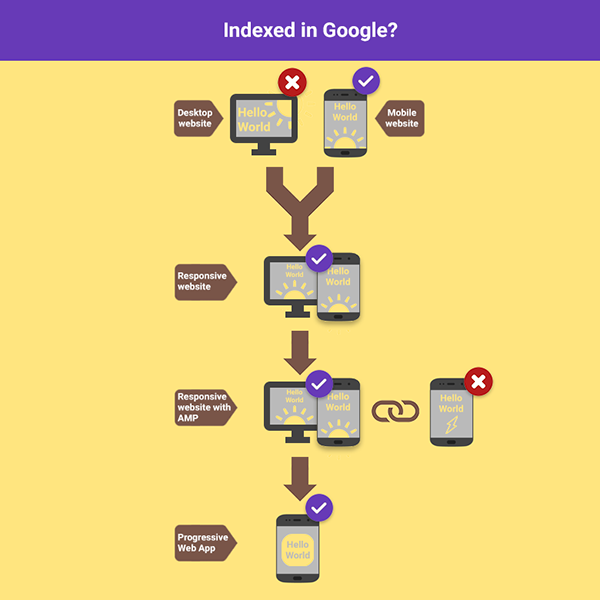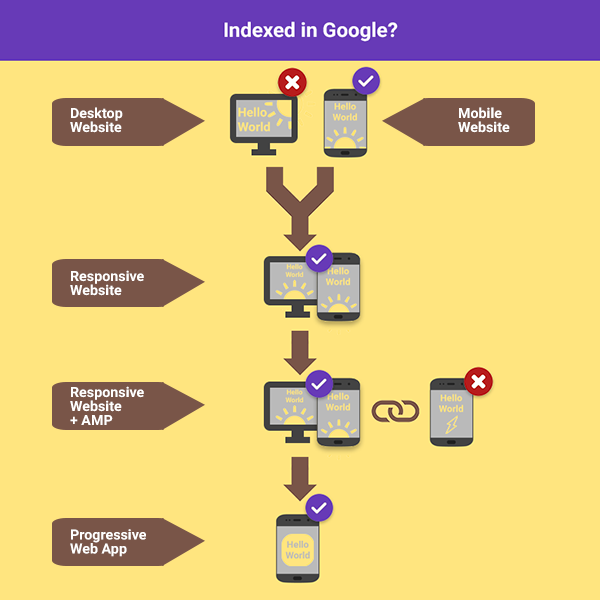
 On Monday, Google announced that they would be indexing mobile pages of websites in search listings in preference to desktop versions; but what exactly does this mean, and what is the thinking behind the move?
On Monday, Google announced that they would be indexing mobile pages of websites in search listings in preference to desktop versions; but what exactly does this mean, and what is the thinking behind the move?
Google’s crawling, indexing and SEO ranking system has until now indexed the desktop version of website content. This has led organisations such as large companies and newspapers to create two versions of all their website pages: a normal (desktop) page, and one built specifically for mobile users – known as an Accelerated Mobile Page (AMP).
Up until now, when these sites offered a great user experience for both desktop and mobile users respectively, Google rewarded them with higher page rankings in both mobile and desktop search results. However, in this latest move, Google is taking this a step further by specifically prioritising content that works well on mobiles in search results.
Furthermore, the link in the search listings – regardless of whether it is seen on a mobile screen or a desktop – will take the end user to the mobile-friendly page.
Does that mean desktop results will now be dominated by AMP versions of websites? Well, no. Google says, “For sites that have AMP and non-AMP pages, Google will prefer to index the mobile version of the non-AMP page.”
So, is Google saying that AMP is on its way out, and instead responsive websites will once again take priority in search results, even for news listings on mobile phones? That would seem like a retrograde step since the whole purpose of AMP (which was, in part at least, developed by Google) was to make the web faster for mobile end users.
Every news agency and media outlet has adopted AMP and all first page results about any news item have the amp symbol next to them. (Want to check this? Search for today’s headline news on your mobile phone right now).
What is Google’s strategy?
The latest update has raised a few eyebrows in our office, because it will prioritise non-AMP website pages over AMP ones, while simultaneously indexing mobile-friendly content over non-mobile-friendly content. In short:
- There will be only one set of search results – whether end users search on mobile or desktop, the results are the same
- Mobile-friendly content will be indexed ahead of other content, regardless of the device the end user is searching on
- AMP content is the most mobile-friendly of all, yet non-AMP content will be prioritised over AMP
Confused? You should be!
However, there is another development underway which does help to make sense of all this. It is the rise – encouraged by Google – of Progressive Web Apps.
Progressive Web Apps (PWAs) combine the best features of websites and apps to produce a kind of hybrid that offers app-like speed and functionality, through a website.
More than just a development in style – the appearance of an app mimicked on the web – PWAs can be accessed offline, send push notifications to a phone and are reached through a homepage icon. To all intents and purposes they are apps… but in reality they are websites.
It seems that Google is now starting the process of side-lining its AMP design, and instead paving the way for PWAs. Let’s not forget that part of the reason Google introduced AMP pages was to counter the growing trend in app downloads (if users are cocooned inside native apps, they are not browsing Google’s marketplace – the internet). Google knows end users want an app-like experience. Delivering that experience through the web will be a big win for Google.
Your next step
Does all of this mean that you should abandon AMP development and rush instead to get a Progressive Web App?
Well, we would not go quite that far, not yet at least.
The history of the web is littered with the discarded remains of Google innovations which were all heralded as the next big thing. Following Google’s updates and announcements as closely as we do and for as long as we have, instils a definite sense of caution.
Having said that, there is no doubt that PWAs can be a great asset to your company.
A PWA will allow the user to download a “shortcut” to the desktop of their phone screen, so that anyone who enjoys your products or services can quickly access it, without having to subscribe or download an App. As well as this, once the user has downloaded the shortcut onto their phone, it will also show notifications your company may have, such as a new product or sale, to an already coherent and actively engaged audience.
By creating a PWA website, your company can immediately improve its website’s stick-ability. Additionally, PWAs are easier to index for Google – which already rings an all too familiar sound of new SEO rules to follow to remain in favour of the almighty Google giant.
So that’s one theory: Google are making way for a new type of website that you should be updating to, side-lining AMP and bringing in PWAs instead.
However, there is another somewhat simpler possibility: Google are encouraging websites to improve their user experience, based on their data that most people use mobiles above all other devices to search online.
As the old saying goes, “give the people what they want”, which in the case of the internet is fast access to information.
It could be that Google understands how the user experience has changed over the years, with pretty images and fancy animations no longer equating to a user-friendly experience. In fact, this new rule could mean that simple content and website structure that looks good on mobiles could be the key to improving bounce rates and user experience for your website on desktops as well.
Whatever the reasons behind this latest update from Google, understanding where marketing, website development and SEO are heading is crucial in remaining ahead of your competitors.
If you are wondering how best to deliver a website experience that satisfies your end users and Google in equal measure, get in touch now.